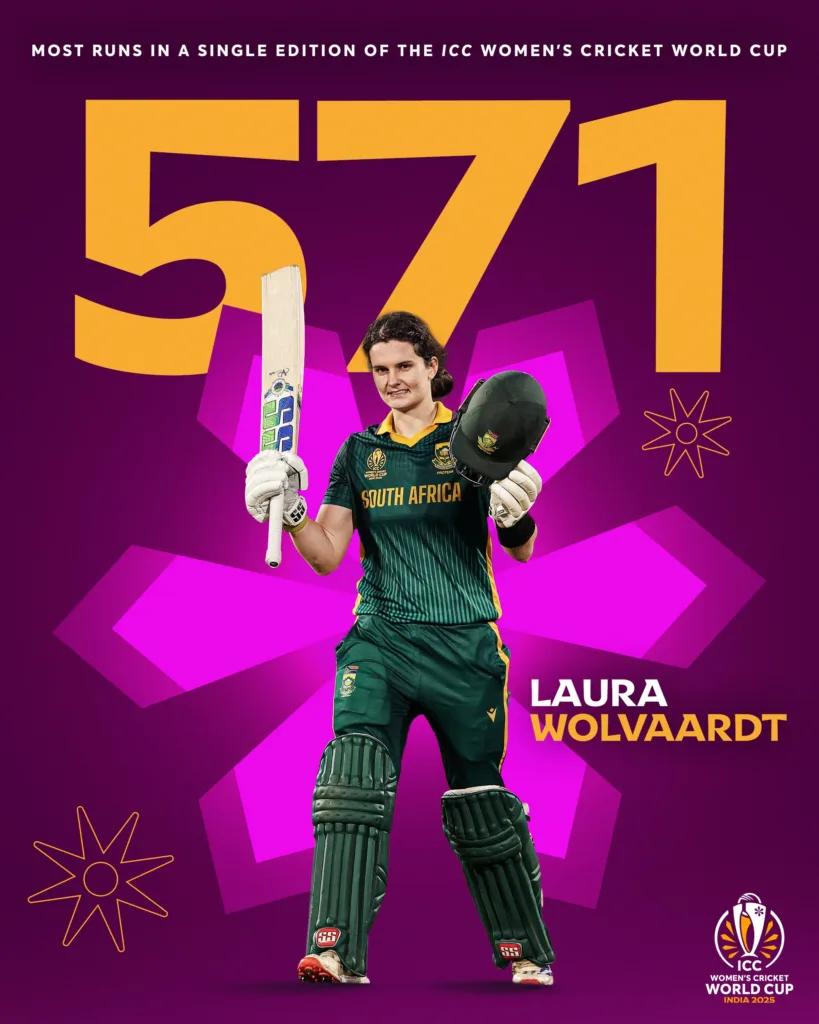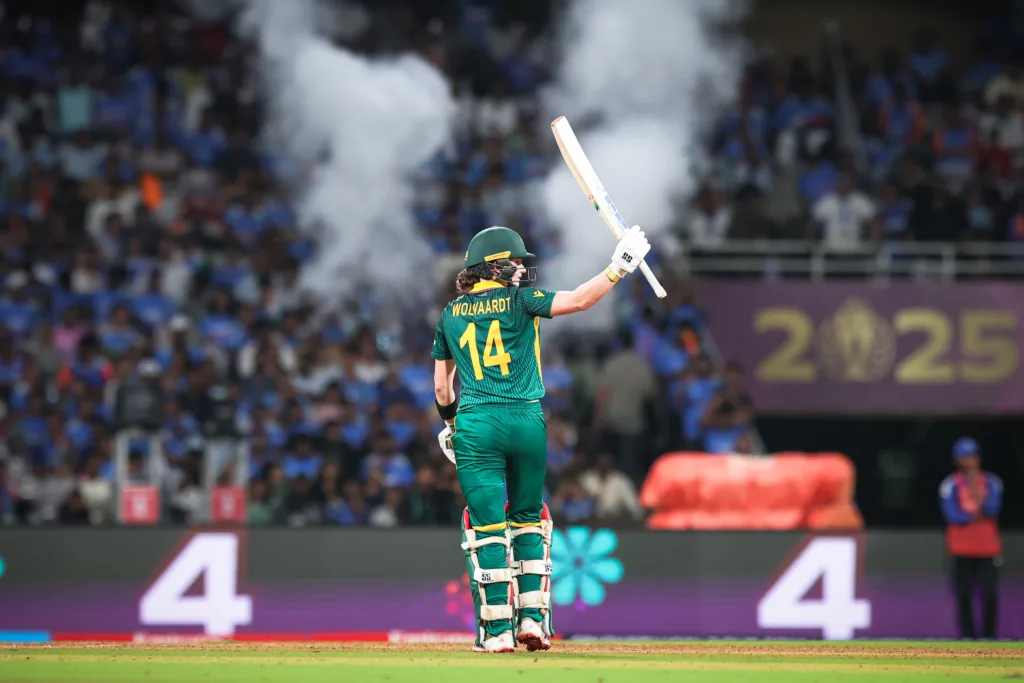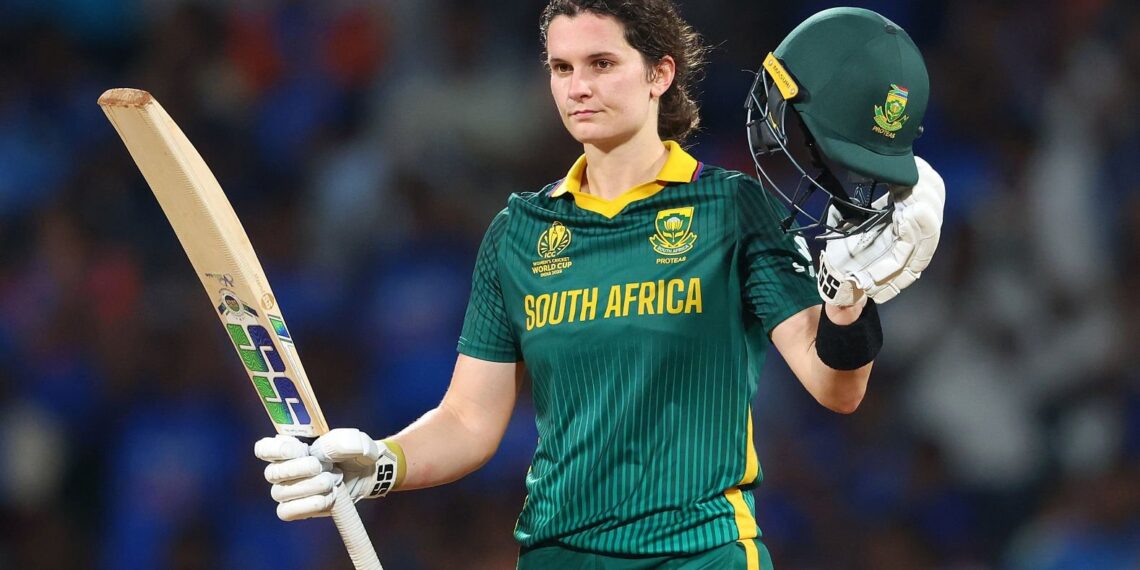Laura Wolvaardt has dethroned Smriti Mandhana to become the world’s top-ranked ODI batter following a sensational Women’s World Cup campaign that saw the South African captain amass a record-breaking 571 runs. The 26-year-old’s back-to-back centuries in the semi-final against England (169) and final against India (101) propelled her to a career-high rating of 814 points, three ahead of Mandhana’s 811, in the latest ICC rankings released on November 4, 2025.
Table of Contents
The Record-Breaking World Cup Performance
Laura Wolvaardt’s 571-run aggregate represents the highest individual tally in a single Women’s World Cup edition, surpassing previous records and cementing her status among the tournament’s all-time greats. Across nine innings, the right-handed opener displayed remarkable consistency, technical mastery, and the ability to deliver under pressure when her team needed her most.
| Match Stage | Opponent | Score | Outcome | Significance |
|---|---|---|---|---|
| Group Stage | Various teams | Multiple scores | Steady accumulation | Building momentum |
| Semi-Final | England | 169 | South Africa won | Match-winning knock |
| Final | India | 101 | India won by 52 runs | Valiant century in defeat |
| Total | 9 innings | 571 runs | World Cup record | Most runs ever in single edition |
Wolvaardt’s 169 against England in the semi-final stands as one of the tournament’s defining performances, steering South Africa to their first-ever World Cup final appearance. Her century in the final, though ultimately in a losing cause as India triumphed by 52 runs to claim their first title since 1986, demonstrated her class and composure on cricket’s grandest stage.

The South African skipper’s tournament showcased not just statistical excellence but leadership under extreme pressure. Captaining her nation in knockout matches while carrying the burden of scoring responsibilities required mental fortitude that few possess at just 26 years of age.
The Rankings Shift: Wolvaardt Overtakes Mandhana
Laura Wolvaardt jumped two spots in the latest ICC Women’s ODI batting rankings to claim the No. 1 position, achieving a career-high rating of 814 points. Smriti Mandhana, who held the top spot throughout the entire World Cup, slipped to second with 811 points after scoring 45 in the final and 24 in the semi-final against Australia—relatively modest returns compared to her tournament standards.
Updated Top 5 ICC Women’s ODI Batting Rankings:
| Rank | Player | Country | Rating Points | Movement |
|---|---|---|---|---|
| 1 | Laura Wolvaardt | South Africa | 814 | ↑ 2 spots |
| 2 | Smriti Mandhana | India | 811 | ↓ 1 spot |
| 3 | Ash Gardner | Australia | TBD | ↓ 1 spot |
| 7 (joint) | Ellyse Perry | Australia | TBD | ↑ 3 spots |
| 7 (joint) | Sophie Devine | New Zealand | TBD | Position held |
| 10 | Jemimah Rodrigues | India | TBD | ↑ 9 spots |
The overtaking represents the first time Mandhana has relinquished the top spot since claiming it, marking a significant moment in women’s cricket rankings. Despite losing her No. 1 position, Mandhana’s tournament was exceptional by any standard—she accumulated 434 runs including a century and two half-centuries—but Wolvaardt’s knockout heroics proved decisive in the rankings calculation.
Mandhana’s World Cup: Excellence Despite Rankings Slip
While media attention focuses on rankings changes, context reveals Smriti Mandhana’s World Cup campaign was outstanding. The Indian opener was named in the ICC Team of the Tournament alongside Wolvaardt, recognition of her consistent contributions throughout the competition.
Mandhana’s tournament featured several memorable innings that helped India navigate the group stage and advance through the knockout rounds. Her elegant left-handed strokeplay and ability to provide solid starts were instrumental in India’s championship triumph, even if the semi-final and final didn’t produce her biggest scores.
Mandhana scored 45 in the final and 24 in the semi-final—contributions that, while not match-defining, provided India with platforms to build upon. In team sports, rankings shifts often fail to capture the nuance of individual performances within winning contexts.
The Indian opener held the No. 1 ranking throughout the entire World Cup, testament to her consistency entering the tournament and during the group stages. Her slip to second doesn’t diminish a career that has established her as one of women’s cricket’s most elegant and effective batters.
Other Significant Rankings Movements
The post-World Cup rankings update reflected several notable changes beyond the top spot, with knockout performances creating substantial rating shifts.
Jemimah Rodrigues’ Breakthrough:
India’s Jemimah Rodrigues climbed nine spots to reach the top 10 for the first time in her career, rewarding her match-winning century against Australia in the semi-final at Navi Mumbai. The innings showcased Rodrigues’ maturity and ability to deliver in pressure situations, establishing her as a genuine middle-order force in ODI cricket.
Rodrigues’ emotional celebration after reaching her hundred captured the moment’s significance—years of hard work and criticism about her consistency finally vindicated on cricket’s biggest stage. Her elevation to the top 10 reflects growing recognition of her talent and reliability.
Ellyse Perry’s Resurgence:
Australian all-rounder Ellyse Perry moved up three spots to joint-seventh position after scoring 77 in the semi-final against India. The veteran’s continued excellence at 35 years old demonstrates remarkable longevity and adaptability as women’s cricket evolves tactically and physically.
Perry shares seventh position with Sophie Devine, who announced her ODI retirement after the World Cup. New Zealand’s failure to reach the semi-finals marked a disappointing end to Devine’s illustrious 50-over career, though her legacy as one of the format’s great all-rounders remains secure.
All-Rounder Rankings:
Deepti Sharma, named Player of the Tournament, moved up one spot to fourth in the all-rounder rankings with 392 rating points, surpassing Australia’s Annabel Sutherland (388). Deepti’s seven wickets and 82 runs across the knockout matches showcased her value as a genuine all-rounder capable of influencing games with both bat and ball.
The Context: A Bittersweet Achievement
Laura Wolvaardt’s ascent to World No. 1 carries profound bittersweet undertones. She achieved the career milestone while experiencing heartbreak—losing the World Cup final in front of passionate Indian crowds after coming tantalizingly close to delivering South Africa’s first-ever global ODI title.
The final at DY Patil Stadium in Navi Mumbai on November 2, 2025, ended with India victorious by 52 runs, triggering scenes of jubilation across the subcontinent. For Wolvaardt and her teammates, the defeat represented crushing disappointment despite reaching unprecedented heights for South African women’s cricket.
Wolvaardt’s century in the final—a composed, fighting innings under immense pressure—couldn’t prevent India’s coronation but ensured her personal legacy from the tournament transcends the result. Great players produce memorable performances regardless of outcomes, and Wolvaardt’s World Cup campaign exemplifies this principle.

The ranking achievement provides consolation but doesn’t erase the final’s sting. In post-match interviews, Wolvaardt expressed frustration at falling short while acknowledging her team’s historic progress. Reaching a World Cup final represented a breakthrough for South African women’s cricket, even if the ultimate prize remained elusive.
Comparing Eras and Records
Wolvaardt’s 571-run haul surpasses previous Women’s World Cup records, inviting comparisons with past greats who dominated tournaments. The achievement places her alongside legendary names who have produced exceptional World Cup campaigns throughout the tournament’s history.
Historic Women’s World Cup Single-Edition Run Tallies:
| Player | Year | Runs | Country | Tournament Outcome |
|---|---|---|---|---|
| Laura Wolvaardt | 2025 | 571 | South Africa | Runners-up |
| Previous records | Various years | Lower totals | Multiple nations | Various outcomes |
The record underscores modern batting’s evolution—improved fitness, refined techniques, better preparation, and enhanced understanding of ODI batting strategies have elevated scoring standards. Wolvaardt’s consistency across nine innings, avoiding significant failures while producing match-winning contributions, reflects elite-level performance sustainability.
The Leadership Dimension
Beyond personal statistics, Wolvaardt’s World Cup campaign highlighted her growing leadership capabilities. Captaining South Africa to their maiden World Cup final while shouldering primary scoring responsibilities demonstrated maturity beyond her years.
Effective sports captaincy requires balancing personal performance with team management—making tactical decisions, managing personalities, maintaining morale through adversity, and delivering when the team needs inspiration. Wolvaardt excelled across these dimensions throughout the tournament.
Her semi-final 169 came when South Africa needed someone to dominate England’s quality attack. Her final century arrived when chasing a challenging target against India’s spinners on turning pitches. Both innings showcased her ability to rise to occasions, a quality that separates good players from great ones.
What This Means for Women’s Cricket
The rankings change and World Cup performances underscore women’s cricket’s increasing competitive depth and quality. Multiple players from different nations competing for the No. 1 ranking reflects the sport’s globalization and professionalization.
Ten years ago, dominance by one or two nations characterized women’s ODI cricket. Today, South Africa reaching World Cup finals, India claiming titles, and players from various countries occupying top rankings positions demonstrates genuine competitiveness that enhances the sport’s appeal and credibility.
Wolvaardt’s emergence as World No. 1 provides role models for aspiring South African cricketers and reinforces that success pathways exist beyond traditional powerhouses. Her technical soundness, mental toughness, and leadership offer blueprints for developing players worldwide.
Looking Ahead: Maintaining the Summit
Becoming World No. 1 represents one challenge; maintaining that position presents another. Rankings fluctuate based on recent performance, meaning Wolvaardt must sustain excellence in upcoming bilateral series and tournaments to hold off challenges from Mandhana and others.
South Africa’s upcoming ODI fixtures will test Wolvaardt’s consistency and ability to perform across diverse conditions. The psychological aspect of being the hunted rather than the hunter also requires adjustment—opponents will specifically target the world’s best batter with enhanced scrutiny and detailed planning.
For Mandhana, the rankings slip likely fuels motivation to reclaim the top spot. The marginal three-point difference suggests future performances could quickly reverse positions. This competitive dynamic benefits women’s cricket, creating compelling narratives around individual excellence and rankings battles.
The Human Story
Behind statistics and rankings lies a human story of dedication, sacrifice, and resilience. Laura Wolvaardt’s journey from promising talent to world’s best ODI batter involved countless hours in training facilities, managing setbacks, handling pressure, and constantly refining her craft.
Her composure during the World Cup final, batting with grace and determination even as the match slipped away, revealed character as much as skill. The ability to accept defeat with dignity while maintaining personal standards exemplifies sportsmanship that transcends results.
Similarly, Smriti Mandhana’s grace in stepping aside from the No. 1 ranking while celebrating her team’s World Cup triumph demonstrates perspective. Individual accolades matter, but team success often provides deeper fulfillment—a principle Mandhana’s post-final celebrations powerfully illustrated.
A New Era Dawns
Laura Wolvaardt’s coronation as ODI cricket’s No. 1 batter marks a significant moment in women’s cricket’s evolution. A South African captain claiming the summit after a record-breaking World Cup campaign reflects the sport’s growing global competitiveness and increasing standards.
The achievement comes with bittersweet context—ultimate team success eluded Wolvaardt at the World Cup final—but her personal excellence stands independent of that result. Great players produce memorable performances regardless of outcomes, and Wolvaardt’s 571-run campaign will be remembered as one of the tournament’s defining narratives.
For Smriti Mandhana, losing the No. 1 ranking by three points doesn’t diminish her standing as one of the game’s elite batters. Her World Cup-winning campaign and consistent excellence maintain her position among women’s cricket’s finest players.

As both players continue their careers, this rankings battle promises compelling cricket. The narrow margin separating them ensures future performances will determine supremacy, creating storylines that enhance the sport’s appeal and give fans reasons to follow women’s cricket more closely.
The post-World Cup landscape features a new World No. 1, a world champion team, and renewed optimism about women’s cricket’s direction. Laura Wolvaardt stands atop the rankings, but the competition chasing her ensures that position will be fiercely contested in the months and years ahead.
Read More: Amol Muzumdar: The Real-Life Kabir Khan Who Led India to Maiden Women’s World Cup Glory
FAQs
How many runs did Laura Wolvaardt score in the Women’s World Cup 2025?
Laura Wolvaardt scored 571 runs across nine innings in the Women’s World Cup 2025, the highest aggregate for any player in a single edition of the tournament’s history.
What is Laura Wolvaardt’s ICC ODI batting rating?
Laura Wolvaardt achieved a career-high rating of 814 points in the ICC Women’s ODI batting rankings, three points ahead of Smriti Mandhana’s 811 points.
Did Laura Wolvaardt win the Women’s World Cup 2025?
No, despite scoring centuries in both the semi-final (169 vs England) and final (101 vs India), Laura Wolvaardt’s South Africa lost the final by 52 runs as India claimed their first title since 1986.
How many spots did Smriti Mandhana drop in the ICC rankings?
Smriti Mandhana dropped just one spot from No. 1 to No. 2 in the ICC Women’s ODI batting rankings after the World Cup, finishing with 811 rating points.
Which other Indian player entered the top 10 ODI rankings?
Jemimah Rodrigues climbed nine spots to reach the top 10 for the first time in her career after her match-winning century against Australia in the World Cup semi-final at Navi Mumbai.








